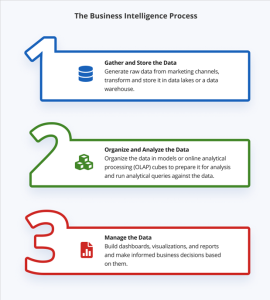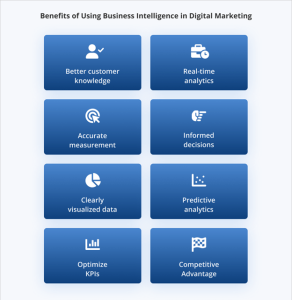How to leverage Business Intelligence within Corporates
Digital marketing offers a significant benefit over traditional marketing in that it is easily trackable, allowing for extensive business intelligence (BI). Almost all online marketing channels have built-in analytics or can be combined with a third-party solution to track how people interact with them and assess their effectiveness. Big data, on the other hand, comes with a lot of responsibility, and it’s critical to make sense of all these figures and put them to work for you.
To obtain, organise, analyse, and display data derived from many sources, business intelligence employs a number of tools and strategies. Using a variety of business intelligence techniques, you may take a data-driven approach to your digital marketing strategy and drastically boost campaign performance.
Business intelligence’s main goal is to help you take advantage of the constant flow of data generated by modern marketing platforms and use it to make better business decisions. Manually sorting and evaluating this sea of data can be time-consuming for some and nearly impossible for the majority. Fortunately, in the digital age, we have access to sophisticated tools and artificial intelligence to assist us and make our jobs easier.
To deliver comprehensible information, a business intelligence solution can integrate data from your CRM software, social media, email campaigns, site-wide tagging, and all other sources. Continue reading to learn how to incorporate business intelligence into your digital marketing strategy and significantly improve the performance of your campaigns.

Find the Right Business Intelligence Tools for Your Company
There are numerous excellent BI tools available, each with a plethora of useful features. To make an informed decision and a wise investment, first define your goals and consider which ones add value to your strategy without incurring additional costs. After all, there’s no point in buying the most expensive solution on the market if you’re not going to use all of its fancy features.
Consider the following factors when determining which software will best meet your requirements:
Who will use it?
Examine your human resources and think about who will be using the business intelligence software. Is it going to be a techie, an analyst, a marketer, or just an ordinary person? Pro solutions can be very advanced and produce detailed results, which is why they frequently require an experienced analyst to operate them. Experts know what to do with data, and the business intelligence programme will assist them in doing so more quickly and precisely.
Furthermore, if you purchase such a tool but do not have an expert on your team, it may be difficult and time-consuming to educate someone to become familiar with it, and they may never become fully fluent in it. As a result, you won’t be able to fully utilise all of the software’s features. Self-service solutions, on the other hand, can be managed by any marketer on your team but give you less control over the tasks you can complete. This means that if you have data analysts on board who know their way around the data and want to be involved in every step of the process, they may see the automated software as a complication rather than a benefit.
Overall, the BI tools you invest in should be appropriate for the level of expertise of your team members. To make the best decision, consider your company’s manpower as well as their ability to work with the new software. If you lead a small team, you can even invite everyone involved to participate in the research and decision-making process. To summarise, even the smartest solutions, if not implemented correctly, will fail to deliver the expected results and may become a waste of time, money, and resources.
Embrace The Data-Driven Approach
Big data powers business intelligence. However, in order for raw data to be transformed into intelligence that can be used in your digital marketing strategy, it must first be transformed, stored, analysed, dashboarded, and visualised. Many modern solutions are self-service, which means they can be managed by users with no technical or analytical background. The processes are automated, and the program’s interface is simple to use.
However, as previously stated, if you have advanced users on board, you may want to invest in a tool that gives the user more control and involvement in the processes.
In business intelligence, data is processed in a series of steps that, depending on the tool, may have varying degrees of self-service:
Gather and Store the Data
Of course, it all starts with generating data from the platforms and channels you use, such as CRM software, social media, website tracking, and analytics from various channels. This data is unprocessed and must be cleaned, sorted, and transformed before it can be used. Some tools use raw data from data lakes and perform data transformation in-app, whereas others require a connection to a data warehouse where the data has already been transformed.
Organize and Analyze the Data
Following that, the data must be organised into models or online analytical processing (OLAP) cubes. The goal of this step is to standardise the information into consistent and manageable forms that can be analysed and understood. When the data is ready, analytics professionals and business users can run analytical queries against it. The process is simplified in self-service tools and can often be completed by entry-level users with a point-and-click interface. The software analyses and aggregates data before converting it into meaningful and structured information.
Manage the Data
Finally, the modelled data is used to create dashboards, visualisations, and reports for decision-makers to use in strategic and tactical planning.
Enjoy the Benefits of Using Business Intelligence in Digital Marketing
Business intelligence can be a powerful tool for the success of your marketing department. Using a data-driven approach allows you to realise the full potential of your digital campaigns and optimise the ROI of marketing channels.
Furthermore, by digging deeper into the data, you can gain valuable insight into your customers’ preferences and purchasing habits. You can feed historical data and real-time market data into your tools and cross-reference it with data from other sources to create accurate predictive models that can assist you in making informed decisions.

Concluding Thoughts
Many businesses question the effectiveness of their marketing department and wonder if the investment in digital channels is worthwhile. Using business intelligence tools and tactics enables marketers to focus on tried-and-true strategies, adjust course in real-time, and back up their decisions with data. A data-driven approach to marketing budget and resource distribution will allow you to optimise campaign performance and ROI while also running a transparent and efficient strategy.
REFERENCES
- Rud, O. P. (2009). Business intelligence success factors: tools for aligning your business in the global economy (Vol. 18). John Wiley & Sons.
- Boyer, J., Frank, B., Green, B., Harris, T., & Van De Vanter, K. (2010). Business intelligence strategy. A Practical Guide for Achieving BI Excellence, Ketchum, USA.
- Jalil, N. A., & Hwang, H. J. (2019). Technological-centric business intelligence: Critical success factors. Int. J. Innov. Creat. Chang.
